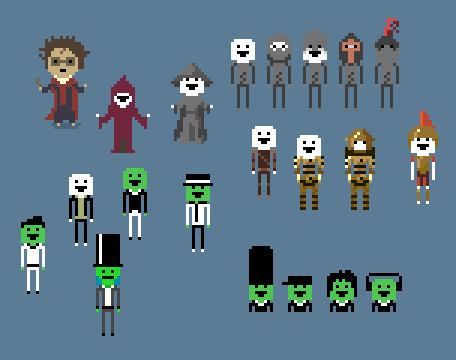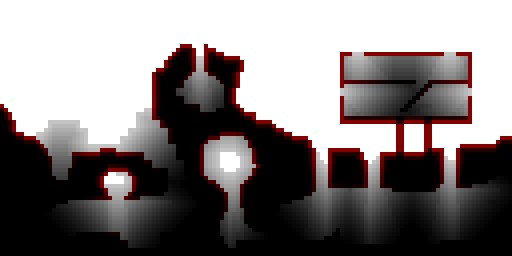
Yesterday, CEDE, from the tigsource forums, posted this cool sketch of a scene from moonman. Thanks dude!
(This is the Day 8 entry for the 30 day world building challenge.)
 Fashion in the fourth (municipality), is chaotic, anachronistic, and almost never practical. A lad of the ultra-violence persuasion has a range of close combat armour to choose from, fashioned from leather, iron, gold, ebony, steel, emerald, sandsteel, sunstone, paper, wood, kapur bark, and, well, practically anything that would resist a solid whack from a sawn-off claymore. The transcendant, the magikal and the soul-less, prefer lighter clothing, typically cloaks, bedsheets, or armour made from less dense materials, such as moonstone. This clothing is typically resonant with the wearer, amplifying whatever godless gift they have. And finally, the ultra-passive citizens of the fourth usually don’t wear armour, but prefer to wear whatever is the current style, from formal suits, shirts with white paints, gangster costumes, renaissance-era garb, whatever takes their fancy really. Head-wear or masks are often worn, from richly decorated feathered hats down to simple accessories, such as the +1 culture monocle.
Fashion in the fourth (municipality), is chaotic, anachronistic, and almost never practical. A lad of the ultra-violence persuasion has a range of close combat armour to choose from, fashioned from leather, iron, gold, ebony, steel, emerald, sandsteel, sunstone, paper, wood, kapur bark, and, well, practically anything that would resist a solid whack from a sawn-off claymore. The transcendant, the magikal and the soul-less, prefer lighter clothing, typically cloaks, bedsheets, or armour made from less dense materials, such as moonstone. This clothing is typically resonant with the wearer, amplifying whatever godless gift they have. And finally, the ultra-passive citizens of the fourth usually don’t wear armour, but prefer to wear whatever is the current style, from formal suits, shirts with white paints, gangster costumes, renaissance-era garb, whatever takes their fancy really. Head-wear or masks are often worn, from richly decorated feathered hats down to simple accessories, such as the +1 culture monocle.
(This is the Day 7 entry for the 30 day world building challenge.)
The fourth municipality of Oed is home to a number of human and human-sized creatures. Categorising these creatures into “race” by tracing evolutionary trees is impossible, as the old rogue magiks have distorted even these lineages. Many creatures exist which have no “biological” ancestors, spawning from the echo of an idea of a mad sorceror of a time long gone. Despite this, groups of similar beings gather into cliques, some of which have names, and others which don’t. Some groups of note are:
(This is the Day 6 entry for the 30 day world building challenge.)
Excerpt from St. P. Naturality Guidebook…
Although Oed has become dominated by the “intelligent” species, leading to the inevitable extinction of much of its wondrous wildlife, a considerable number of species still exist. Magiks run astray have torn the planet’s weather system apart, leading to chaotic and unpredictable weather and a landscape that changes far more rapidly than evolution has catered for. Nonetheless, the species that remain dominate their niche and have learnt to survive in these wildly changing conditions. Restricting our attention to those in the fourth municipality (Figure ii), we see a number of unique and interesting lifeforms.
Of the air creatures, the zweibird is the rarest. Although with rich pink feathers, when it is in range it is hard to miss, fluttering and flittering about the trees and bushes, hunting for worms, bugs, and wyrm-bugs. The zweibird is uniquely biological, as reproduction in the female occurs not by giving birth but by spontaneously splitting into two new zweibirds, of equal size. A curiosity indeed! The mottled crow needs no explanation, it is seen everywhere in Oed, and is a scavenger. The eagal on the other hand, is one of Nature’s great species, vivid emerald feathers gleam in the sunlight, and a full span of its wings can rival that of a full grown person! The eagal is oft found perched on jutting cliff faces, high up in the mountains, where its perfect vision can search the ground for its prey, typically rabbits and zweibirds.
If roaming at night, one may come across the nightbird, a dark grey bird-like creature with fire-red eyes which glow at night. You may be tempted to flee, but don’t, the nightbird is harmful in appearance only, and feeds only on the bugs that are attracted by moonlight. However, the nightbird has a distant cousin, the firebird, which lives under the surface, closer to the core. It glows with the fire that runs through its veins, and is vicious towards anything which stumbles into its domain. If venturing deep underground, it is highly recommended you take the appropriate precautions and carry medical supplies for treating burns.
(This is the Day 5 entry for the 30 day world building challenge.)
This book is a reference for the study of fungi, Mycology. It covers numerous topics in depth, including: taxonomies, practical acquisition of fungi, toxicological information, as well as several recipes for delicious mushroom stew. If you are new to the study of Oed’s most colourful and delightful organisms, then you are in for a treat. Mycology is a rewarding and fulfilling branch of science, nay, the most rewarding and fulfilling. A practicing mycologist can be expected to venture deep into the earth to collect specimens of the rarest mushrooms, thwarting attempts on his life by wild animals, beasts and bats. The hallucinogenic properties of some fungi means that mycologists are often The Life Of The Party, and typically have a wide circle of acquaintances. It isn’t all fun and games, though, a mycologist must devote his entire life to the serious study of fungi in all its forms — fungi is essential for medicine, food, and magiks (and Ale of course!) and only by advancing the state of the art can the people of Oed evolve. — Preface to “The Mycologist’s Index”.
(This is the Day 4 entry for the 30 day world building challenge.)
Excerpt from Page 17 of the St. P. Alc. Eyebook…
The creators of this world were truly the greatest of combinatorists. There are a finite number of elements, each of which has a relationship with the others. The Table above illustrates these relationships, the elements, except Air, lie in the top row, and their reactive friends lie below. These elements are: The Air [1] which breathes life into all of God’s creations, and is inert towards all the other elements; The Moonstone [2] which warms and lights our way at night. Remarkably, when Moonstone and Sunstone are within a small distance of each other, a low hum can be heard. Luckily, there isn’t enough Moonstone in our world for there to be an eternal hum; Third, we have Phosphor [3], a common reagent in many topes and remedies; Fourth is Gold [4], the bearer of the divine glow, the possession of which has resulted in many wars, including the longest, the Many Wars; Platinum, or Crowmium [5], can be molten in a Sunstone hearth, and formed into impenetrable armours and structural materials; Sunstone [6], or God’s Heart, the maker of fire. Sunstone is used to break down the elements and recombine them. It is also added to many processes in order to strengthen materials and add heat. For instance, HM’s throne contains a small amount of Sunstone in which to keep HM at a constant temperature.
(This is the Day 3 entry for the 30 day world building challenge.)
The Bell Tower, of origin unbeknownst, stood weary on the tor,
There was great power within its walls, but would not toll anymore,
Some argue that, upon one chime, another would succeed,
And from the depths, where the daemons slept, would awake an ancient fiend.
– Unknown

The last two days I’ve been exploring light for moonman, that is, how to efficiently and nicely shade the blocks appropriately based on the transport of light. Check my devlog for info, but here are some nice pics of a work in progress. :)



(This is the Day 2 entry for the 30 day world building challenge.)
The geography of Oed is as varied as the pastries cooked by the fifth Lord’s master pâtissier. The following is an excerpt from the JE Atlas, a series of geographical and anthropological surveys performed by the team of expert spelunkers Jula and Ela, during the rule of the Crow.
(This is the Day 1 entry for the 30 day world building challenge being run over at tigforums.)
It was the world of a thousand names, Oed, Qusayma, Suevia, the mother world. For the inhabitants of Oed’s only moon, Lunem, it was heaven, luminescence, and the logical conclusion to an illogical life. It hung in the sky and lit the night up with a comforting hue. For the thirty thousand nine hundred and eight six million three hundred and ninety one thousand and seventeenth Lunem-man — coincidentally the first man to escape the immense gravity of the dense moon — Oed was to be his fate. In one of a billion possibilities, in a multitudinous-many-every-verse like his, the Lunem-man crashed landed on Oed, and awakened eight millenia later.
Oed is a terrestrial planet like most, it has oxygen, water, rich minerals, vegetation and animal life. It is also populated by many intelligent civilisations competing for these resources. The landscape of Oed is rich and varied. From high plains balanced precariously on thick naturally forming columns of sand-stone down to torrential rivers of fire near the planet’s core. There is an abundance of rich minerals most of which are mined and processed by the advanced species. The Mosa Of The Undergound, for instance, create sand-steel through a number of organic processes, which they use to build their impenetrable giant dome-nests.
Oed is extremely dangerous. The roads above ground are just as dangerous as the spidery intertwined cave systems. Creatures travel in daylight and night. They fly, scurry, burrow, slime, climb, and osmose. Early explorers to new parts of Oed would often be found dead in their make-shift fortresses, unaware of the matter-transcending capabilities of the Lyre. Oed is a vicious place, the air viscous with death.
Beware the creatures of Oed! The dangerous ___________ and the __________ are typical encounters on a midnight stroll. Without the proper training you will surely be made a meal of. — Excerpt from “The Mycologist’s Index”. (Edited by E)